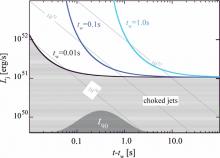
Abstract
The central engine of short gamma-ray bursts (sGRBs) is hidden from direct view, operating at a scale much smaller than that probed by the emitted radiation. Thus we must infer its origin not only with respect to the formation of the trigger—the actual astrophysical configuration that is capable of powering an sGRB—but also from the consequences that follow from the various evolutionary pathways that may be involved in producing it. Considering binary neutron star mergers we critically evaluate, analytically and through numerical simulations, whether the neutrino-driven wind produced by the newly formed hyper-massive neutron star can allow the collimated relativistic outflow that follows its collapse to actually produce an sGRB or not. Upon comparison with the observed sGRB duration distribution, we find that collapse cannot be significantly delayed (≤100 ms) before the outflow is choked, thus limiting the possibility that long-lived hyper-massive remnants can account for these events. In the case of successful breakthrough of the jet through the neutrino-driven wind, the energy stored in the cocoon could contribute to the precursor and extended emission observed in sGRBs.